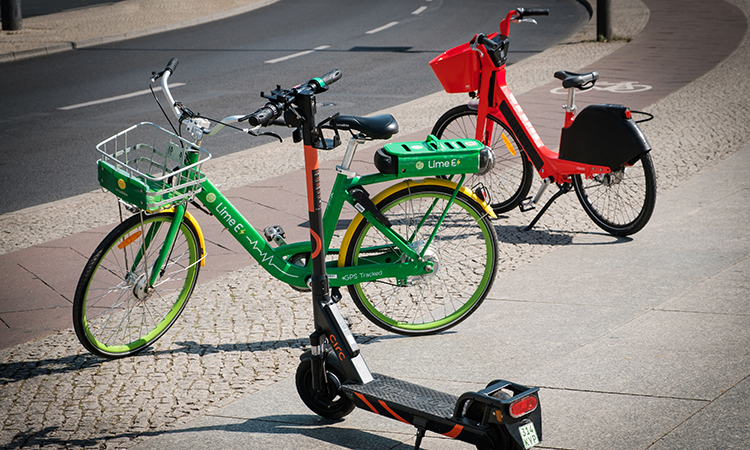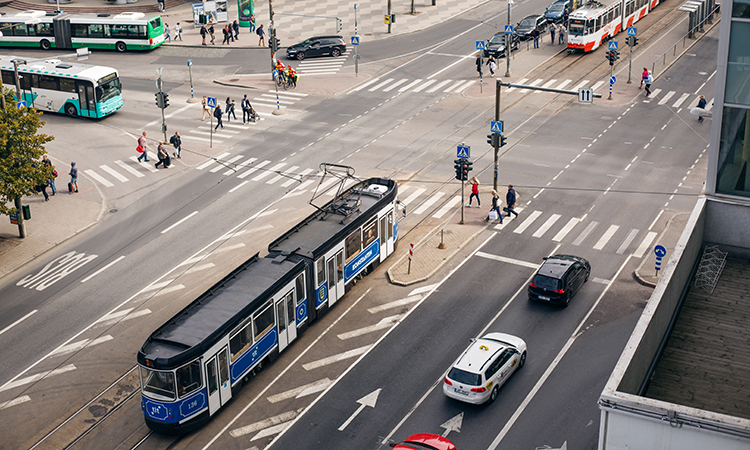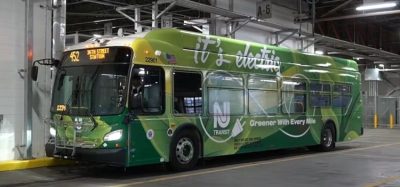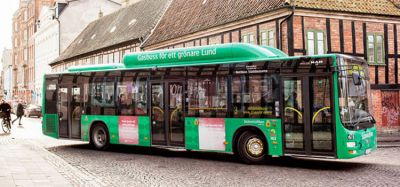Making the most of MaaS during and after COVID-19
- Like
- Digg
- Del
- Tumblr
- VKontakte
- Buffer
- Love This
- Odnoklassniki
- Meneame
- Blogger
- Amazon
- Yahoo Mail
- Gmail
- AOL
- Newsvine
- HackerNews
- Evernote
- MySpace
- Mail.ru
- Viadeo
- Line
- Comments
- Yummly
- SMS
- Viber
- Telegram
- Subscribe
- Skype
- Facebook Messenger
- Kakao
- LiveJournal
- Yammer
- Edgar
- Fintel
- Mix
- Instapaper
- Copy Link
Posted: 17 March 2021 | Piia Karjalainen - MaaS Alliance | No comments yet
Piia Karjalainen, Secretary General of the MaaS Alliance, explains what needs to be done to successfully implement MaaS schemes around the globe, with a strong focus on data sharing and public-private collaboration.


After the pandemic, more than ever, our world will need convenient and smart mobility solutions. With its expected positive impacts in making our transport systems more sustainable and resilient, MaaS has the potential to be the game-changer in everyday mobility. The coming months will present numerous opportunities to upgrade our urban mobility systems and take giant leaps in driving transformation that even a year ago seemed time‑consuming and politically challenging.
Stimulus and recovery packages are now planned in cities and countries across the world to help economies out of the COVID-19 crisis and support future-proof digital and green solutions. Targeted financial and regulatory measures can also be used to support the regional and national MaaS roadmaps and the creation of inclusive and sustainable MaaS ecosystems. With better integrated, multimodal services we can make our transport system more sustainable (with reduced emissions) and efficient (by optimising resources and operations of transport systems), but also more resilient and agile for possible forthcoming crises and disruptions.
What needs to be done in practice?
In the current development phase of MaaS, regulation is, first and foremost, a tool to build trust among the industry stakeholders. It sets a clear framework and ambition facilitating the development of the industry and creating a predictable environment for investments in both the public and private sector.
In order to encourage innovation and new services, the regulation should remain business model and technology agnostic and set a level playing field with non-discriminatory market access. Although people mostly move and operate within one city or region, covering only one area is not enough to fulfil all mobility needs. Therefore another important task of regulation is to decrease market fragmentation and support the development of scalable services beyond isolated city islands.
Funding is similarly important to support innovation and deployment. A challenge that our sector now faces is a low amount of investment channelled to the new mobility industry, due to the fact that investors remain cautious while waiting for clearer signals of a speedy and full recovery of our economies. Stimulus packages and strong aligned messages from governments emphasising the urgency for green and digital solutions are now needed to help the sector through the funding gap, hindering its capacity to innovate, invest and bring forward comfortable and smart mobility solutions to the market.
How do we build the foundation for MaaS?
Without any doubt, the most cited graphics of the MaaS world is the MaaS integration level model (Jana Sochor, Hans Arby et al). It has been used to measure the advancement of the different MaaS initiatives, to communicate the competitive advantages of MaaS services over those of competitors, and to highlight the importance of public-private partnership to establish societally beneficial Mobility-as-a-Service schemes. Now, I am using this graphic to demonstrate where the focus of actions should be put when enabling MaaS at its different maturity levels.
Table 1 (below) is a simplified version of the technical and regulatory enablers (not exclusive) needed to achieve certain levels of MaaS. It is important to notice that the mentioned technical and regulatory factors are prerequisites for the achievement of a certain maturity level.
|
MaaS Integration Levels1 |
Main Technical enablers |
Main Policy enablers |
|
No integration: single, separate services |
• • Multimodal services |
• Access to new mobility market |
|
Integration of information: Multimodal journey planner, price info |
• Static & dynamic data • Open APIs for data sharing • Common data formats |
• Common data formats and open APIs |
|
Integration of payment: Find, book and pay a single trip |
• Digital payment and validation methods • Open APIs for planning, booking and payment |
• Access to ticket resale • Multimodal passenger rights schemes • Incentives for data exchange, interoperability framework |
|
Contractual integration: Bundling & subscription |
• Data feedback loop to service≈providers |
• Access to ticket resale, all ticket types • Flexibility in terms of pricing when reselling the services • Comprehensive passenger rights/consumer rights and privacy schemes • Creation of non-discriminatory and competitive market |
|
Policy integration: Governance & public-private coordination |
• Data feedback loop to public authorities |
• Incentives for the sustainable modes and travels • Aligned policies across the sectors and administrative borders (subsidies, taxation etc) • Comprehensive mobility budget approach • Framework for impact assessment and compliance |
This means that the investment and regulatory plans should reflect the desired level of MaaS developments and support it with proactive and timely policies and financial measures.
In addition, the table shows that while in the less mature MaaS schemes the role of the technical enablers is more dominant, there is a more important role for regulation when more mature MaaS is in sight and desired. If some of the critical technical components are missing, targeted funding programmes in addition to private investments can be considered to fill in the missing pieces, while policy enablers might require introduction of soft or hard law measures.
Public transport is and should remain the backbone of MaaS. The most efficient public transport systems benefit from the idea of complementary services, where mass transit solutions are complemented by various shared and on-demand services.
The development of multimodal integrated systems and services can be accelerated by ensuring the viability and high quality of public transport services and networks, as well as by investing in integration readiness and interoperability of public transport systems.
When allocating stimulus funding, the digitalisation of public transport ticketing and payments systems would be high-value investments. In order to build up the foundations for integrated services, opening up ticketing and reservation system interfaces for other service providers can be mandated in return for received funding.
High-quality physical infrastructure is similarly important. If the basic network for walking, biking, public transit and shared services is not available, MaaS will not solve the challenges. It is key to keep in mind that the whole user experience is important, from the moment the user closes the door behind them, until they are at their destination. More focus is needed to ensure the good service level of multimodal nodes, mobility hubs that serve users, and providers of DRT, car rental or clubs, bike-shares (including cargo and e-bikers), parcel lockers, as well vital non-mobility related services.
Data is at the heart of MaaS
Data infrastructure must enable interoperability, competition and innovation, while ensuring privacy, security, and accountability. When it comes to the interoperability of data schemes, the key components for the MaaS market are: firstly, common data standards (common language); and secondly, harmonised open APIs availability (common interface).
The hindrances related to fragmentation causing high administrative and scalability costs could be tackled most efficiently by supporting collaboration towards a harmonised approach. Coordinated EU-level and international industry-led efforts and funding to support technical interoperability and standardisation, including funding for implementation of standards, would represent a great boost for the development of scalable integrated services. They would also reduce costs of cities, public transport authorities and operators at the later stage.
In order to build real multiplayer, multi-option market platforms, the service operators should provide each other with access to essential information in digital format, including routes, timetables, stops, prices and accessibility information. Ideally, the necessary datasets would be made voluntarily available (in digital, machine readable, non-proprietary format), but if that is not the case, regulatory obligations may be needed.
Data sharing does not necessarily equal free data, but data sharing and exchange models should be designed between partners to be fair and to fit for purpose. Often, reciprocity or quid-pro-quo models offer the most neutral pathway to the progressive exchange of data. Also, public procurement can be used to foster data exchange and ecosystem interoperability by setting requirements for data sharing formats and the use of common APIs in public tendering. The requirements can be used either as ex ante selection criteria or as a requirement for the selected solution and/or service provider.


User buy-in is key to making MaaS work
The user is always key
In MaaS, the main focus should always be on the user and how we can increase their where-to-go network and freedom of choice in sustainable mobility. Without a strong buy-in from users, the benefits of MaaS cannot be unlocked. Governments should be a strong voice for protecting consumer rights and privacy of the users. The policy framework for data access and use should put the individual in the central position and make ethical data sharing and MyData principles the norm. In a MaaS market, individual data portability does not just make customer choice simpler and more seamless, it also makes roaming between several MaaS services possible.
One factor supporting the status-quo, rather than the uptake of new sustainable services, is the way that incentive schemes within the transport system are often linked to the use of fixed, owned assets while similar incentives are not available for the use of shared resources.
In order to ensure that environmentally-friendly mobility services are treated equally in terms of financial incentives, we should re-evaluate such incentive schemes and enable the use of an optimised mobility mix including shared fleets and mobility services, especially in multimodal urban environments.
The goal is a more easily understandable scheme for users and employers, who I believe will play an important role in the future of MaaS, supporting the adoption of new daily mobility habits.
In this context, interesting opportunities lie in the concept of subsidies and incentives directly allocated to end-users. The incentive scheme could take the form of tax deductions based on the use of public transport or shared mobility services; tax incentives for the acquisition of e-bikes and e-scooters; or allocation of micro-subsidies to be spent on multimodal, sustainable services.
In order to build comprehensive and aligned schemes, a stronger collaboration between the administrative departments responsible for transport, finance, housing and national health would be beneficial at all levels of administration and throughout the various jurisdictions.
The future of MaaS development should be built on an enhanced public-private partnership and complementarity. The creation of a MaaS ecosystem that delivers the policy objectives cannot be built alone with state-of-the-art technologies nor visionary policies. Eventually the success will be determined based on user uptake, which requires the seamless collaboration of all actors, from infrastructure providers to operators, urban planners to application designers and a commitment to focus on delivering sustainable and easy mobility to users.
To that end, MaaS Alliance members have been working together to suggest principles, entitled “MaaS Market Playbook”, for a thriving MaaS ecosystem and innovative partnerships. In our thinking, governance should ensure the accountability towards the desired policy goals and support the open ecosystem, with a co-existence of different technologies and business models.
It is of utmost importance that the governance framework is built in collaboration and with a participatory approach by both the public and private sectors, including market newcomers, while keeping users in mind. This playbook will be published in the forthcoming weeks and I hope that it will provide inspiration for the further implementation of MaaS.
Biography
Piia Karjalainen is Secretary General of the MaaS Alliance – an international public-private partnership established in 2015, bringing together more than 100 member organisations worldwide, supporting the development of MaaS ecosystems based on the principles of openness, inclusivity, sustainability and user-centricity. Karjalainen leads and coordinates all the activities of this international MaaS community.
Previously, she has held various positions at the European Parliament and the Finnish Ministry of Transport & Communications, mainly dealing with transport strategies, ITS, MaaS, policymaking and EU regulation. She holds a Master of Science in Economics.
Related topics
Business Models, COVID-19, Infrastructure & Urban Planning, Multimodality, On-Demand Transport, Public Transport, Transport Governance & Policy
Related organisations
The MaaS Alliance
Related people
Hans Arby, Jana Sochar








